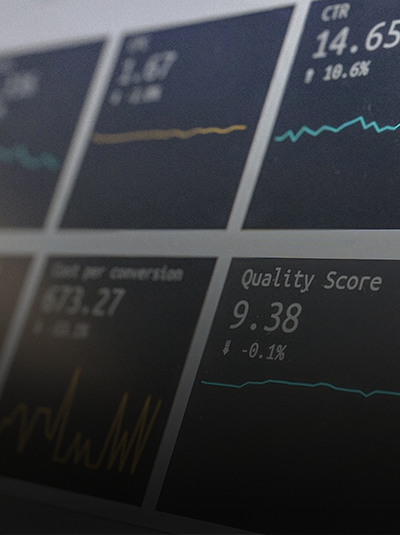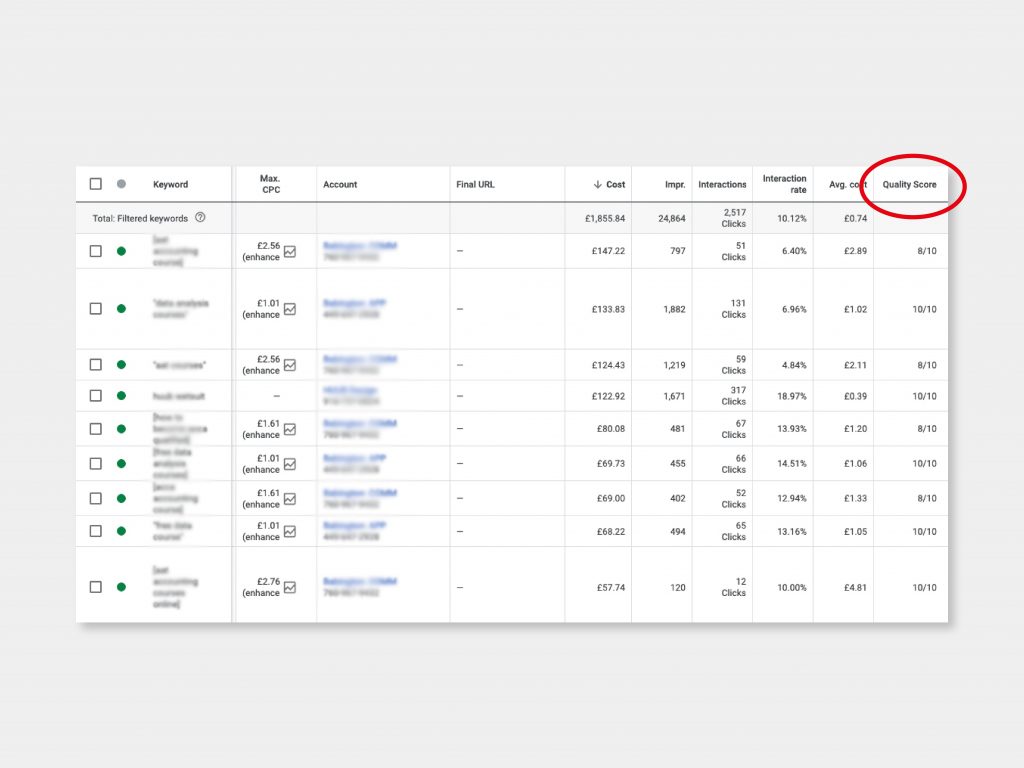How to increase your Google Ads Quality Score?
22nd Feb 2022

What is Google Ads Quality Score?
All Google Ads have a quality score, which is given on a scale of 1-10. It reflects Google’s aim to make the world’s information accessible and useful, as well as pointing out how relevant the ad is.
The score is an estimate of the quality of your PPC adverts. Google checks your target keywords and landing pages compared to other advertisers. After taking these factors into account, you will be awarded a quality score, that helps Google to sort out all the adverts.
While especially rewarding advertisers that use PPC advertising correctly by giving them higher placements on SERPs (Search Engine Result Pages). Additionally, Quality Score is re-calculated each time a user search triggers an ad, there is no need to worry your score will be outdated.
If you’re already working on your Google Ads Campaigns, it’s worth checking out our 5 tips to Optimise your Google Ads Campaign.

Can Quality Score affect my results?
The answer can get a bit technical. So, let’s start by explaining the difference between ‘Quality Score’ and ‘Ad Rank’.
- Quality Score – Quality Score is a chosen rating by Google (from 1-10) that represents overall experience of your ads, landing pages, and keywords. It is used as a guideline of where to improve your ads’ effectiveness.
- Ad Rank – it’s a value, given by Google, to determine where your ads are shown on a page, comparing it to other ads. It’s calculated using bid amount, auction-time ad quality, Ad Rank thresholds, the competitiveness of an auction, the context of the person’s search, and the expected impact. In a nutshell, it evaluates your ad potential relevance, for the user, and performance, which can directly affect price (if done correctly you may get a discounted price by around 50%, alternatively if done wrong – you may pay up to 400% more per click).
Although, the Ads Quality Score doesn’t affect Google’s algorithm directly, it’s a good indication of how well your ad would perform (a low ranking score is considered anything under 5, while anything over 7 is considered good).
So, if your Quality Score is low, that will most likely present itself as a low ad ranking, in other words – it’s a metric that will help you create higher quality ads.
Important note: since Google takes so many factors into account while calculating your Ad Rank, it’s possible to outperform your competitors, who use higher bid values, by having highly relevant ads.
How does this make sense?
Well, by following Google Ads Quality Score you will improve the relevance of your ads and Google cares about relevance A LOT. They prefer the ads that are the most likely to get clicked, rather than the ones who pay the most while having a low-Quality Score. Google wants to maximise profit. By showing ads that are more likely to get clicked (higher quality score) they make more money.
How does Google determine my Quality Score?
Google takes 3 main factors into account while calculating Quality Score:
- Expected Click Through Rate (CTR) – How likely are your ads going to be clicked on, based on your chosen keywords.
- Ad Relevance – Will the ad makes sense for your chosen keyword search results? Google looks at how relevant the ad is based on the keywords you chose. Don’t know how to find the right keywords? Learn how to do Keyword Research, here.
- Landing Page User Experience (UX) – How relevant your landing page content is to the advert? Does it match what the ad offer? Additionally, Google looks at the website design (it’s very important to have your website mobile-friendly) and it’s loading speed.
The most important thing to keep in mind is that Google only wants to deliver users information that’s relevant to them. If you tailor your ads and landing pages for what users are searching for (a.k.a. understand search intent behind your keywords), good performance will follow.
How to improve your Google Ads Quality Score?
As we’ve already determined, Quality Score is very important to improve your performance. It’s a metric that can be used as a general indicator of what areas you should focus on. So, what are these areas and how do you improve your quality score? Keep in mind, that Quality Score components are evaluated by 3 statuses: ‘Above Average’, ‘Average’, or ‘Below Average’. These statuses are based on data of the same keyword in the last 90 days.
What’s next? The first step should be taking a deep dive into the main 3 factors that Google uses to determine Quality Score. As these hold the most value.
Expected Click-Through Rate (CTR)
This metric represents how likely will your chosen keywords match the search terms. It doesn’t care about anything else. Keep in mind, that you will see 3 possible statuses around your expected CTR:
- Average & Above Average – this indicates that there are no significant problems with your keywords.
- Below Average – you should change your ad copy and reconsider your main keywords.
A lot of times, if you see ‘below average’ status, you might have not used your keywords in the ad copy itself. For example: if you’re targeting a keyword for ‘sustainable coffee pods’ – mention it in the ad title and description.
Our tip would be to create more than one ad group. Make a variety of ads with the preferred keywords, this will help you determine what keywords work the best. Continue monitoring your best/worst performing keywords, double down on the ones that work – remove the ones that don’t.
Additionally, you should experiment with CTA, try out different options to find out what works. Try highlighting the unique benefits that you’re offering, 50% sale, free delivery, etc. Lastly, don’t forget to be specific.
Ad Relevance
Ad Relevance is all about matching your keywords to what you’re trying to say – your message. If your ad relevance is on ‘Below Average’ status, you should start making some changes. Adjust your copy to be more specific regarding your chosen keywords.
For example, if your target keyword is ‘sustainable coffee pods’ you should emphasise that instead of advertising for just ‘coffee’. Alternatively, if you sell a variety of coffees, you should create keyword themes i.e., ‘sustainable coffee pods’, ‘ground coffee’, ‘coffee beans’.
Landing Page Experience
Simply put, if you’re talking about ‘car engines’ on your landing page, but your ad talks about ‘car tires’ – Google won’t like that. Your chosen landing page should represent the same topic and keywords your ads are focusing on. Moving away from the copy, your landing page should also be easy to navigate, relevant to the search intent, organised, and mobile-friendly.
This is especially important to avoid high bounce rates. If people don’t find what they expect to find on the landing page – they will just leave. Which will increase your bounce rate and push down your ranking.
Make sure to provide helpful information to your product/service, relevant links to your other web pages, and easy to find contact information.
Note: other factors related to Ad Rank may affect your ads performance, that are not encompassed by Quality Score. These factors include, but aren’t limited to:
- Device – the type of device person used to search.
- Location – especially important when targeting based on location.
- Time – you can choose to only show your ads at a certain time of the day.
Key Takeaways
- Always chose the most relevant keywords for your campaign.
- Your ads only appear where they match users’ search intent. Keep this in mind.
- Optimise your landing page, it should include relevant keywords and information regarding your offer. Additionally, it highly recommended to make your website fast and mobile-friendly.
- Try keeping your quality score above 7.
- Lastly, if you think this might be a bit too complicated to do it yourself, you can always leave it to Google Partnered Experts!



